Bedienungsanleitung - Viessmann Modellspielwaren GmbH
Bedienungsanleitung - Viessmann Modellspielwaren GmbH
Bedienungsanleitung - Viessmann Modellspielwaren GmbH
Sie wollen auch ein ePaper? Erhöhen Sie die Reichweite Ihrer Titel.
YUMPU macht aus Druck-PDFs automatisch weboptimierte ePaper, die Google liebt.
Gebrauchsanleitung<br />
Manual<br />
4556<br />
Servo-Antrieb mit Zubehör<br />
Servo-Drive with accessories<br />
4553<br />
Kontaktsatz für Servo-Antrieb<br />
Contact Set for servo-drive<br />
4556<br />
1. Wichtige Hinweise...................................... 2<br />
2. Einleitung.................................................... 2<br />
3. Lieferumfang 4556 + 4553.......................... 2<br />
4. Aufbauhinweise.......................................... 3<br />
5. Anwendungsbeispiele................................. 5<br />
6. Technische Daten....................................... 8<br />
1. Important Information................................. 2<br />
2. Introduction................................................. 2<br />
3. Content of 4556 + 4553.............................. 2<br />
4. Mounting..................................................... 3<br />
5. Examples.................................................... 5<br />
6. Technical Data............................................ 8<br />
4553
D<br />
1. Wichtige Hinweise<br />
Lesen Sie vor der ersten Benutzung des Produktes<br />
bzw. dessen Einbau diese Anleitung komplett und<br />
aufmerksam durch. Bewahren Sie diese Anleitung<br />
auf. Sie ist Teil des Produktes.<br />
Das Produkt richtig verwenden<br />
Das Produkt darf ausschließlich dieser Anleitung<br />
gemäß verwendet werden. Dieser Servo-Antrieb<br />
ist bestimmt<br />
– zum Einbau in Modelleisenbahnanlagen,<br />
– zum Anschluss an ein zugelassenes Steuermodul<br />
für Servo-Motoren,<br />
– zum Betrieb in trockenen Räumen.<br />
Jeder darüber hinausgehende Gebrauch gilt als<br />
nicht bestimmungsgemäß. Für daraus resultierende<br />
Schäden haftet der Hersteller nicht.<br />
2. Einleitung<br />
Servo-Antriebe eignen sich hervorragend zum Beispiel<br />
zum Öffnen von Lokschuppentoren, Drehen<br />
von Wasserkränen, Stellen von Weichen, Signalen<br />
und Entkupplern und vielen anderen langsamen Bewegungen.<br />
Sie zeichnen sich durch hohe Stellkraft<br />
und geringe Geräuschentwicklung aus.<br />
In Verbindung mit einem Servo-Controller (z. B.<br />
<strong>Viessmann</strong> 5268) können Sie Servo-Antriebe auch<br />
auf der Modelleisenbahn einsetzen.<br />
3. Lieferumfang<br />
4556 – Servo-Antrieb<br />
Folgende Teile gehören neben dieser Anleitung zum<br />
Lieferumfang.<br />
Abb. 1<br />
1<br />
1 Servo-Antrieb<br />
1 servo-drive<br />
EN<br />
1. Important Information<br />
Please read this manual prior to first use of the<br />
product resp. its installation! Keep this manual. It is<br />
part of the product.<br />
Using the product for its correct purpose<br />
This product must only be used as required in this<br />
manual. This servo-drive and contact set are intended<br />
– for installation in model railroad layouts,<br />
– for connection to an authorized control module<br />
for servo-drives,<br />
– for operation in a dry area.<br />
Using the product for any other purpose is<br />
not approved and is considered incorrect.<br />
The manufacturer cannot be hold responsible for<br />
any damage resulting from the improper use of<br />
this product.<br />
2. Introduction<br />
The <strong>Viessmann</strong> servo-drives are very quiet<br />
and provide high torque to the actuating wire.<br />
You can now use the servo-drives for your model<br />
train layout in combination with a servo controller<br />
(e. g. <strong>Viessmann</strong> 5268).<br />
Servo-drives are perfectly suitable for switching<br />
turnouts, signals or un-coupler, opening of the<br />
gates of an engine shed, turning of water cranes<br />
(spouts) and many other movements.<br />
3. Content<br />
4556 – Servo-Drive<br />
The following parts and this manual are part of this<br />
set.<br />
4<br />
Fig. 1<br />
2 Hebelscheiben<br />
2 lever discs<br />
2<br />
3<br />
1 Halterung<br />
1 holder<br />
2 Distanzrollen<br />
2 spacing coils<br />
5<br />
6<br />
7<br />
75 mm Stelldraht<br />
inkl. Adapter<br />
75 mm set wire<br />
with adaptor<br />
1 Schraube<br />
1 screw<br />
1 Mitnehmer<br />
1 coupling means<br />
2
4553 – Kontaktsatz<br />
Der Kontaktsatz ist eine separat erhältliche Ergänzung<br />
zum Servo-Antrieb und umfasst die in Abbildung<br />
2 gezeigten Teile.<br />
Abb. 2<br />
4553 – Contact set<br />
The contact set 4553 is a separat upgrade for the<br />
servo-drive and includes the following parts.<br />
Fig. 2<br />
A<br />
2 Distanzrollen<br />
2 distance coils<br />
C<br />
2 Schaltkontakte<br />
2 switch contacts<br />
D<br />
1 Schraube<br />
1 screw<br />
B<br />
2 Schaltnocken<br />
2 switch cams<br />
E<br />
2 Schrauben<br />
2 screws<br />
4. Aufbauhinweise<br />
Nehmen Sie den Servo-Antrieb vorsichtig aus<br />
der Verpackung. Führen Sie vor der Montage<br />
eine Funktionskontrolle durch. Schließen Sie den<br />
Servo-Antrieb dazu an ein passendes Steuermodul<br />
(z. B. <strong>Viessmann</strong> 5268) an.<br />
Vorbereiten des Stelldrahtes<br />
Der Stelldraht wird mittels Adapter am Servo-<br />
Antrieb befestigt. Um den Stelldraht am Adapter<br />
zu befestigen, gehen Sie wie in Abb. 3 gezeigt vor:<br />
Biegen Sie ein Ende des Stelldrahtes mit einer<br />
Rundzange vorsichtig zu einer Öse mit einem Außendurchmesser<br />
von 3,4 mm. Die Öse muss in die<br />
Vertiefung des Stelldraht-Adapters passen.<br />
Kürzen des Stelldrahtes<br />
Kürzen Sie den Stelldraht nur mit einer geeigneten<br />
Zange für Federstahldraht oder einem geeigneten<br />
Seitenschneider. Bei Verwendung eines anderen<br />
Werkzeuges beschädigen Sie möglicherweise dessen<br />
Klinge.<br />
Achtung! Verletzungsgefahr durch abspringende<br />
Drahtstücke! Tragen Sie eine Schutzbrille! Aus Sicherheitsgründen<br />
sollten Sie auch den abzuschneidenden<br />
Teil des Drahtes festhalten, zum Beispiel<br />
mit einer kleinen Flachzange.<br />
Befestigung des Servo-Antriebs<br />
Benutzen Sie zur Befestigung des Servo-Antriebs<br />
an Ihrer Anlagenplatte bitte passende Universal-Schrauben<br />
aus dem Baumarkt und montieren<br />
4. Mounting<br />
Remove the servo-drive from the packaging carefully.<br />
Check function before installation. Thereafter<br />
connect the servo-drive to an adequate control<br />
module (e. g. <strong>Viessmann</strong> 5268).<br />
Prepare the set wire<br />
The set wire has to be connected to the servo-drive<br />
with the enclosed adaptor. Figure 3 shows, how to<br />
mount the wire on the adaptor.<br />
Bend one end of the wire with a round pliers carefully<br />
to an eye with diameter 3.4 mm. The eye has<br />
to fit the deepening of the adaptor.<br />
Cutting the set wire<br />
The actuator rod is made from spring steel wire<br />
and can therefore be shortened only with the correct<br />
side cutters. For safe cutting you should hold<br />
the piece you are cutting off with small pliers.<br />
Attention: Danger of chipping off wire pieces!<br />
Wear safety goggles! To reduce danger, keep the<br />
piece of wire you cut off.<br />
Mounting of the servo-drive<br />
To mount the servo-drive under your baseboard,<br />
please use universal-screws from your local hardware-store.<br />
The template may help you (fig. 3+4).<br />
We recommend the following types<br />
(two pieces of each):<br />
► no spacing coils: 3,5 mm x 12 mm<br />
► with one spacing coil each: 3,5 mm x 30 mm<br />
► with two spacing coils each: 3,5 mm x 50 mm<br />
3
Abb. 3<br />
1 : 1<br />
3,4 mm<br />
Antriebsachse des Servo-Antriebs<br />
driving axle of servo-drive<br />
Fig. 3<br />
3,5 mm<br />
10 mm<br />
20 mm<br />
55 mm<br />
Sie die Halterung mit Hilfe der Schablone (Abb.<br />
3+4).<br />
Wir empfehlen folgende Typen (je zwei Stück):<br />
► ohne Distanzrollen: 3,5 mm x 12 mm<br />
► mit je einer Distanzrolle: 3,5 mm x 30 mm<br />
► mit je zwei Distanzrollen: 3,5 mm x 50 mm<br />
Geräuschdämmung<br />
Die Geräuschentwicklung des Servo-Motors ist gering.<br />
Sie kann jedoch durch einen Resonanzkörper<br />
(z.B. Anlagenplatte) erheblich verstärkt werden.<br />
Wir empfehlen daher, den Servo-Motor auf einer<br />
Moosgummiunterlage (erhältlich im Bastelbedarf)<br />
zu montieren. So reduzieren Sie die Schallübertragung<br />
zwischen Servo-Motor und Anlagenplatte.<br />
Abb. 4<br />
Noise<br />
The noise emission of the servo-drive is typically<br />
very low. But by resonance with the baseboard the<br />
sound can be increased.<br />
Due to this fact, we recommend to mount the servo-drive<br />
on a rubber plate. By doing this, you reduce<br />
the noise transmission between servo-drive<br />
and baseboard.<br />
Fig. 4<br />
4<br />
2 Stück: 3,5 x 12 mm 2 Stück: 3,5 x 30 mm 2 Stück: 3,5 x 50 mm
5. Anwendungsbeispiele<br />
Mit dem <strong>Viessmann</strong> Servo-Antrieb können Sie Bewegung<br />
auf Ihre Modelleisenbahn bringen.<br />
In diesem Kapitel zeigen wir Ihnen, wie Sie die Bauteile<br />
des Servo-Antriebs und des Kontaktsatzes<br />
kombinieren können.<br />
Typische Anwendungen wie Weichenantrieb und<br />
Drehbewegung (Wasserkran oder Tore) haben wir<br />
grafisch für Sie als Anregung und Aufbauhilfe dargestellt.<br />
Kombinationsmöglichkeiten<br />
Den korrekten Zusammenbau der Einzelteile von<br />
Servo-Antrieb (4556) und Kontaktsatz (4553) entnehmen<br />
Sie bitte der Abbildung 5.<br />
Abb. 5<br />
Variante 1: Stelldraht montieren<br />
Set wire<br />
7<br />
6<br />
5. Examples<br />
The <strong>Viessmann</strong> servo-drive enables to bring action<br />
on your model display. The drive is very flexible to<br />
use.<br />
In this chapter, we show you how you can combine<br />
the parts of the servo-drive 4556 and the contact<br />
set 4553.<br />
A typical use for the servo-drive are turnout-drives<br />
and slow rotations (like cranes or doors). You find<br />
these examples in the following grafics as a setupinformation.<br />
Combinations<br />
Figure 5 shows the correct assembly of the parts of<br />
the servo-drive (4556) and the accompanying contact<br />
set (4553).<br />
Fig. 5<br />
Variante 3: Kontaktsatz 4553 montieren<br />
Mounting contact set 4553<br />
7<br />
5<br />
3 A<br />
1<br />
D<br />
5<br />
Variante 2: Hebelscheibe montieren<br />
Mounting lever discs<br />
2<br />
B<br />
4<br />
B<br />
6<br />
3<br />
E<br />
E<br />
C<br />
A<br />
1 1<br />
2<br />
5
Weichenantrieb<br />
Nutzen Sie den <strong>Viessmann</strong> Servo-Antrieb zum vorbildgerecht<br />
langsamen und leisen Umschalten Ihrer<br />
Weichen. Der mitgelieferte Stelldraht bewegt die<br />
Weichenzunge.<br />
Bohren Sie dazu an einer für Ihren Weichentyp passenden<br />
Stelle ein Loch senkrecht durch die Anlagenplatte.<br />
Den Servo-Antrieb montieren Sie, wie in Abbildung<br />
6 gezeigt, unter der Anlage. Schließen Sie den Servo<br />
dann z. B an das <strong>Viessmann</strong> Servo-Steuermodul<br />
5268 an. Damit können Sie Drehwinkel und Endpositionen<br />
bequem einstellen.<br />
Herzstückpolarisierung<br />
Dieser Abschnitt betrifft nur Gleichstrombahner.<br />
Weichen mit elektrisch leitendem Herzstück müssen<br />
polarisiert werden, das heißt die Spannung muss je<br />
nach Weichenstellung umgepolt werden.<br />
Benutzen Sie dazu den <strong>Viessmann</strong> Kontaktsatz<br />
4553 und montieren Sie ihn wie in Abbildung 5 (Variante<br />
3) gezeigt auf dem Servo-Antrieb.<br />
Verbinden Sie die Schaltkontakte mit dem Herzstück<br />
der Weiche (Abb. 7).<br />
Point Motor<br />
Use the <strong>Viessmann</strong> servo-drive for the exemplary<br />
slow and quiet switching of your turnouts. The set<br />
wire moves the point.<br />
Drill a hole through the baseboard at the right position<br />
for your points-type.<br />
Mount the servo-drive under the baseboard as<br />
shown in figure 6. Afterwards, connect the servo to<br />
a servo decoder (e. g. <strong>Viessmann</strong> 5268).<br />
<strong>Viessmann</strong> 5268 allows you to set up comfortably<br />
the turn angle and end positions of the servo-drive.<br />
Polarisation of the core<br />
This chapter concerns only DC model railroads.<br />
Points with electric conducting core have to be<br />
polarised. That means that the voltage has to be<br />
switched depending on the position of the point.<br />
Use the <strong>Viessmann</strong> contact set 4553 and mount<br />
it as shown in figure 5 (variation 3) on the servo-drive.<br />
Connect the switching contacts with the core of the<br />
point as shown in figure 7.<br />
Abb. 6<br />
Fig. 6<br />
Stellstange<br />
set rod<br />
Weiche<br />
turnout<br />
Anlagenplatte<br />
baseboard<br />
Stelldraht<br />
set wire<br />
Bohrung<br />
hole<br />
Distanzrolle<br />
distance coil<br />
Servo mit Stelldraht-Adapter<br />
Servo-Drive with adapter<br />
6
Abb. 7<br />
Fig. 7<br />
Herzstück<br />
Center of turnout<br />
braun<br />
brown<br />
Schaltkontakte (auf Servo montieren)<br />
Switch contact (mount on Servo)<br />
braun<br />
brown<br />
rot<br />
red<br />
Langsame Drehbewegung<br />
Wasserkräne in Dampflok-Betriebswerken oder die<br />
Tore von Lokschuppen können Sie mit dem <strong>Viessmann</strong><br />
Servo-Antrieb in Bewegung bringen. Dazu<br />
müssen Sie die Drehbewegung des Antriebs auf<br />
die Drehachse des Modells übertragen.<br />
Das funktioniert nach dem „Schraubendreher-Prinzip“.<br />
Dazu haben wir den kleinen Adapter beigefügt.<br />
Stecken Sie diesen anstelle des Stelldrahtes<br />
auf den Stelldraht-Adapters (Abb. 8).<br />
Das zu bewegende Modell muss an seiner Achse<br />
einen Schlitz haben, in den der Adapter des Servos<br />
eingreifen kann. Sollte ein passender Schlitz noch<br />
nicht vorhanden sein, feilen Sie diesen bitte mit einer<br />
geeigneten Feile ein.<br />
Für den weiteren Aufbau vergleichen Sie Ihr Modell<br />
bitte mit der folgenden Abbildung.<br />
Slow rotations<br />
Water cranes in steam engine factorys or the gates<br />
of an engine shed can be moved by the <strong>Viessmann</strong><br />
servo-drive. Therefore you have to transfer the rotation<br />
of the drive to the rotation axle of the model.<br />
This works with the “screwdriver-principle”. Use the<br />
coupling means for that. Mount it instead of the<br />
set wire on the set wire adaptor (fig. 8).<br />
The model needs a slot at the axle, in which the<br />
adapter can step in. If there is no fitting slit, please<br />
use a file to make one.<br />
For the mounting refer to figure 8 on the following<br />
page.<br />
7
Abb. 8<br />
Draufsicht / top view<br />
Fig. 8<br />
z. B. Kran<br />
e. g. crane<br />
Gleis<br />
track<br />
Loch ansenken<br />
countersink hole<br />
Anlagenplatte<br />
baseboard<br />
Distanzrolle<br />
spacing coil<br />
Servo mit „Schraubendreher“-Adapter<br />
Servo-Drive with adapter<br />
8. Technische Daten<br />
Anschluss: Steuermodule für Servo-Motoren<br />
Abmessungen: 32 mm x 12 mm x 29 mm<br />
Drehbereich: 180°<br />
Drehmoment:<br />
0,17 kgcm<br />
8. Technical Data<br />
Connection: Control modules for servo-drives<br />
Dimensions: 32 mm x 12 mm x 29 mm<br />
turn range: 180°<br />
torque:<br />
0,17 kgcm<br />
Dieses Produkt ist kein Spielzeug. Nicht geeignet für<br />
Kinder unter 14 Jahren! Anleitung aufbewahren!<br />
This product is not a toy. Not suitable for children<br />
under 14 years! Keep these instructions!<br />
Ce produit n’est pas un jouet. Ne convient pas aux<br />
enfants de moins de 14 ans ! Conservez ce mode<br />
d’emploi !<br />
Dit produkt is geen speelgoed. Niet geschikt voor kinderen<br />
onder 14 jaar! Gebruiksaanwijzing bewaren!<br />
Questo prodotto non è un giocattolo. Non adatto a<br />
bambini al di sotto dei 14 anni! Conservare instruzioni<br />
per l’uso!<br />
Esto no es un juguete. No recomendado para menores<br />
de 14 años! Conserva las instrucciones de servicio!<br />
8<br />
<strong>Modellspielwaren</strong> <strong>GmbH</strong><br />
11/2013<br />
Stand 01<br />
Sach-Nr. 87760<br />
Made in Europe



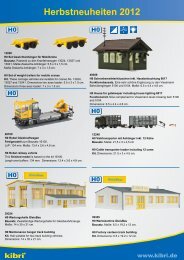
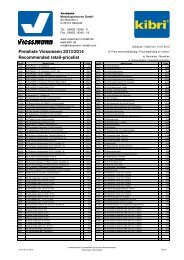

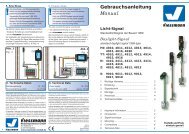
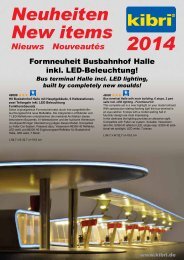
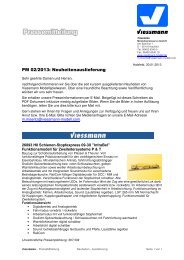


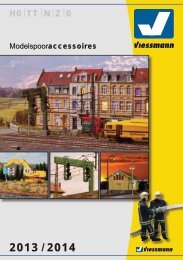
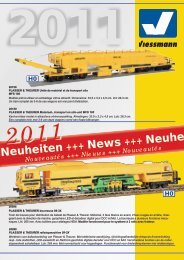
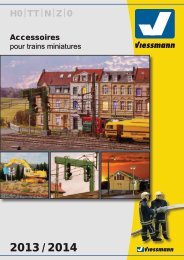
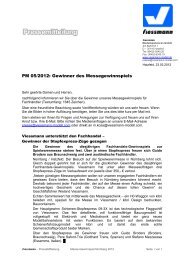
![Interactive News [pdf]](https://img.yumpu.com/13782861/1/190x107/interactive-news-pdf.jpg?quality=85)
